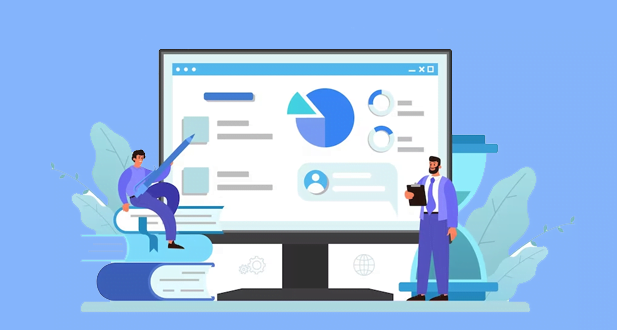About Queue Management System
Queue management system (QMS) is a software-based tool that helps businesses and organizations manage customer traffic flow in an efficient and organized manner. It is a valuable resource for businesses that experience high customer volumes or frequent peak times, such as banks, hospitals, airports, government agencies, and theme parks.
A typical queue management system consists of several components, including software, hardware, and displays. The software component is the core of the system and manages the queue by assigning customers to different service channels, collecting customer data, and generating real-time reports. The hardware component includes queue management kiosks, customer displays, and service displays that help customers navigate the queue and track their position in it. The display component shows real-time information about the queue, such as the estimated waiting time, the number of customers ahead, and the service channels available.
A QMS can be configured in different ways to meet the specific needs of a business. For example, a simple QMS may only have one service channel, while a more complex system may have multiple channels for different services or different types of customers. A QMS can also be integrated with other systems, such as appointment scheduling software, customer relationship management (CRM) software, and enterprise resource planning (ERP) software.
The benefits of using a QMS are numerous. First and foremost, it improves customer satisfaction by reducing wait times and providing a more organized and efficient customer experience. It also reduces staff workload by automating many of the tasks involved in managing a queue, such as customer data collection and service channel assignment. Additionally, it provides valuable data and insights that businesses can use to optimize their operations and improve their customer service.
One of the key features of a QMS is its ability to prioritize customers based on their needs and preferences. For example, a hospital may give priority to emergency cases, while a bank may give priority to high-value customers. A QMS can also be used to manage different types of customers, such as VIPs, regular customers, and first-time visitors. This helps businesses provide personalized service and improve customer loyalty.
Another important feature of a QMS is its ability to monitor and manage customer flow in real-time. This allows businesses to quickly respond to changes in customer traffic and adjust their operations accordingly. For example, if a particular service channel is experiencing a high volume of customers, the QMS can redirect some of them to other channels to reduce wait times and improve customer satisfaction.
In addition to improving customer service, a QMS can also help businesses increase their operational efficiency and reduce costs. By automating many of the tasks involved in managing a queue, such as data collection and analysis, businesses can free up staff time and resources for other tasks. Additionally, by optimizing service channel usage and reducing wait times, businesses can serve more customers in the same amount of time, which can increase revenue and profitability.
One potential drawback of a QMS is the cost of implementation and maintenance. Depending on the size and complexity of the system, the initial investment can be significant, and ongoing maintenance and upgrades may be required. However, the benefits of improved customer service, increased efficiency, and better data and insights can outweigh the costs over the long term.
Purpose of queue management system
A queue management system (QMS) is a set of tools and processes that organizations use to control customer flow and manage queues. The primary purpose of a QMS is to enhance customer satisfaction by minimizing wait times, reducing congestion, and improving service efficiency. Here are some paragraphs that elaborate on the various purposes of a queue management system:
Enhancing Customer Experience
One of the primary purposes of a queue management system is to enhance customer experience. Long wait times and crowded waiting areas can be a source of frustration and anxiety for customers. A QMS can help alleviate this by providing customers with real-time information on queue status, estimated wait times, and service availability. With this information, customers can better plan their time and reduce uncertainty, leading to a more positive experience.
Increasing Operational Efficiency
Queue management systems also help organizations increase their operational efficiency. By optimizing the allocation of resources such as staff, equipment, and space, a QMS can help reduce waiting times, increase throughput, and minimize idle time. This can help organizations maximize the utilization of their resources, reduce costs, and increase profitability.
Improving Service Quality
A queue management system can also help organizations improve their service quality. By providing real-time data on queue status and customer flow, organizations can identify bottlenecks and areas where improvements are needed. This can help organizations improve service delivery, reduce errors and mistakes, and increase customer satisfaction.
Streamlining the Service Process
A QMS can also help organizations streamline their service process. By automating the collection of customer data, organizations can reduce waiting times, improve accuracy, and minimize the need for manual data entry. A QMS can also help organizations prioritize customers based on their needs, enabling staff to provide more personalized and efficient service.
Enhancing Customer Safety and Security
In today’s world, customer safety and security are top priorities for organizations. A queue management system can help organizations ensure the safety and security of their customers by managing crowd flow, minimizing congestion, and preventing unauthorized access. A QMS can also help organizations comply with health and safety regulations by enforcing social distancing measures and controlling customer flow.
Providing Analytics and Insights
Finally, a queue management system can provide organizations with valuable analytics and insights. By collecting data on customer flow, wait times, and service performance, organizations can identify trends and patterns, measure performance, and make data-driven decisions. This can help organizations optimize their operations, improve service delivery, and stay ahead of the competition.
Types of queuing systems
Queuing systems, also known as waiting line systems, are a common feature in many business environments. Queues are formed when there is a mismatch between the arrival rate of customers and the rate at which they can be served. Queuing systems are classified based on various criteria, such as the number of service channels, the arrival pattern, the number of service phases, and the queue discipline. In this article, we will discuss the different types of queuing systems and their characteristics.
Single Server Queuing System
The single-server queuing system is the most basic queuing system, where there is only one service channel available to serve customers. The customers arrive at random intervals and form a queue behind the server. The server serves the customers one by one, and the service time is random. The single-server queuing system is also called the M/M/1 queuing system, where M stands for the Poisson arrival rate, and 1 stands for one server.
Multi-Server Queuing System
The multi-server queuing system is a queuing system with more than one service channel available to serve customers. The customers arrive at random intervals and form a queue behind the servers. The servers serve the customers one by one, and the service time is random. The multi-server queuing system is also called the M/M/m queuing system, where m stands for the number of servers.
Finite Population Queuing System
The finite population queuing system is a queuing system in which the number of customers is limited, and the queue is not infinite. In this system, the customer population is known, and the arrival and service rates are constant. The finite population queuing system is also called the M/M/N queuing system, where N stands for the number of customers in the system.
Infinite Population Queuing System
The infinite population queuing system is a queuing system in which the number of customers is infinite, and the queue is infinite. In this system, the arrival and service rates are constant. The infinite population queuing system is also called the M/M/∞ queuing system.
Priority Queuing System
The priority queuing system is a queuing system in which customers are served based on their priority level. The priority level may be assigned based on factors such as the customer’s age, status, or the urgency of their need. In this system, the high-priority customers are served first, followed by the low-priority customers.
Preemptive Priority Queuing System
The preemptive priority queuing system is a queuing system in which customers are served based on their priority level, and a customer of higher priority can interrupt the service of a customer of lower priority. In this system, the high-priority customers can interrupt the service of low-priority customers, which can lead to a delay in the service time of the low-priority customers.
Non-Preemptive Priority Queuing System
The non-preemptive priority queuing system is a queuing system in which customers are served based on their priority level, and a customer of higher priority cannot interrupt the service of a customer of lower priority. In this system, the high-priority customers are served first, followed by the low-priority customers, and the service of a low-priority customer cannot be interrupted by a high-priority customer.
Benefits of queue management systems
Queue management systems have become an integral part of businesses worldwide. They are designed to streamline the customer flow and enhance customer experience, thereby increasing customer satisfaction and retention. In this article, we will discuss the benefits of queue management systems in detail.
Improved customer experience:
One of the most significant benefits of queue management systems is that they improve the customer experience. Customers no longer have to stand in long queues or wait for their turn to be served. Instead, they can take a ticket or book a time slot and wait in a comfortable seating area. This reduces their perceived wait time and enhances their overall experience.
Increased efficiency:
Queue management systems enable businesses to handle customer traffic more efficiently. They help businesses manage their resources effectively, such as staffing levels, which can be adjusted based on customer demand. This helps businesses avoid overstaffing or understaffing, ensuring that customers receive prompt and efficient service.
Real-time monitoring:
Queue management systems allow businesses to monitor their operations in real-time. They can track customer traffic, monitor wait times, and analyze data to identify areas for improvement. This data can be used to optimize staffing levels, service times, and other aspects of the business, ultimately resulting in a more efficient operation.
Improved staff productivity:
With queue management systems, businesses can optimize their staffing levels, which can improve staff productivity. By avoiding understaffing, staff can focus on providing quality service to customers rather than rushing to attend to them. This can improve staff morale and ultimately enhance the overall customer experience.
Increased revenue:
Queue management systems can help businesses increase revenue by reducing wait times and improving customer experience. When customers have a positive experience, they are more likely to return, recommend the business to others, and spend more money. Additionally, businesses can use the data collected by queue management systems to identify areas for revenue growth.
Reduced stress:
Waiting in long queues can be stressful for customers, which can negatively impact their overall experience. Queue management systems can reduce stress levels by providing customers with an estimated wait time, allowing them to relax and enjoy their surroundings. This can ultimately enhance their overall experience and make them more likely to return.
Increased safety:
In today’s world, safety is a top priority for businesses. Queue management systems can help businesses maintain a safe environment by ensuring that customers are spaced out appropriately. They can also be used to monitor occupancy levels and ensure that businesses are operating within their capacity limits.
Conclusion
In conclusion, a queue management system is a valuable tool for businesses and organizations that deal with high customer volumes or frequent peak times. By automating many of the tasks involved in managing a queue, prioritizing customers based on their needs and preferences, and providing real-time data and insights, a QMS can improve customer satisfaction, increase operational efficiency, and reduce costs. While there may be some upfront costs and ongoing maintenance involved, the benefits of implementing a QMS can be significant for businesses looking to improve their customer service and optimize their operations.
Frequently Asked Questions
Yes, a queue management system can be integrated with other systems such as customer relationship management (CRM) software, appointment scheduling software, and digital signage solutions. This integration allows businesses to streamline their operations and provide a more seamless customer experience.
A queue management system can benefit any business or organization that deals with customer traffic, such as banks, hospitals, government agencies, retail stores, and theme parks.
Some key features to look for in a queue management system include multi-channel check-in options, real-time queue status updates, customizable workflows, reporting and analytics, and integration capabilities with other software systems.
Most queue management systems are designed to be user-friendly and easy to set up. However, the complexity of the setup process may vary depending on the size and complexity of the business.
Yes, some queue management systems can help enforce social distancing measures by limiting the number of customers in a physical waiting area and by providing virtual queuing options.




